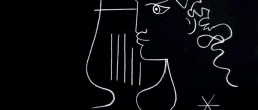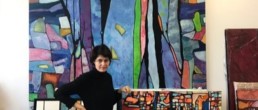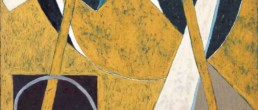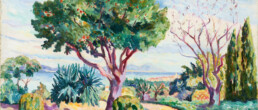Gustave Loiseau
1865 (Paris) - 1935 (Paris)
No work available for the moment.
Biography
Gustave Loiseau was a french Post-Impressionist painter born on October 3rd 1865 and died on October 10th 1935 in Paris. Loiseau’s parents, butcher shop owners, moved to Paris shortly after he was born. He became an apprentice to a decorator friend of the family. His parents soon after sold their business and retired to Pontoise. This town near Paris was important in French painting at the time, its environs having been extensively depicted by Pissarro and Cezanne.
In 1887 Loiseau received a legacy from his grandmother which enabled him to give up his job and devote his life to painting; he establishes in Montmartre and enrols for a year at Decorative Art School, he followed courses in life-drawing, until an argument with his teacher prompted him to withdraw. While still working with the decorator, one of Loiseau’s jobs has been to redecorate the apartment of the painter Fernand Just Quignon. Upon his departure from school, Loiseau turns to this landscape painter as his teacher.
He left for Pont-Aven on the Brittany Coast for the first time in 1890. He befriended the myriad of artists in residence there: Paul Gauguin, Henry Moret, Maxime Maufra and Emile Bernard, they all played important roles in his overall artistic development.
In 1895, Loiseau exhibited in the Salon des Independants and the Societe Nationale des Beaux-Arts where he met the primary patron of the Impressionists, Paul Durand-Ruel, whom put the artist under contract in 1897. The freedom this afforded Loiseau allowed him to travel the country and paint a wide variety of French scenes, seeming to prefer the coastal villages to all others. His post-impressionists views of the River Seine, Dieppe and Pont-Aven proved quite popular in Paris.
He developed an individual take on the Pointillism technique of Georges Seurat and Paul Signac, incorporating the complementary color theories and fluid shapes of Impressionism with rigid brushwork and glowing light. This cross-hatched technique, called en treillis (latticework), which gave his paintings the supple, almost touchable quality he is known for. He advanced the idea of what is acceptable in a landscape painting to include reaching elevated perspectives and rich, exaggerated pigments.
Museums: Buffalo, Dieppe, Geneva (Petit Palais, Musée d’Art Moderne), London (British Museum), New York (Moma), Oxford, Pont-Aven, Rennes, Stuttgard, Saint Petersburg (Hermitage), etc.
Literature:
- Gustave Loiseau et la Bretagne, 1865 – 1935, Musée de Pont-Aven
- Pointillisme, sur les traces de Seurat, A.A.V.V., Losanna, Fondations de l’Hermitage
- G. Schurr, P. Cabanne: Dictionnaire des Petits Maîtres de la peinture, 1820-1920
- Catalogue sommaire illustré des peintures, Musée d’Orsay, Paris, Ed. R.M.N.
Museums: Buffalo, Dieppe, Geneva (Petit Palais, Musée d’Art Moderne), London (British Museum), New York (Moma), Oxford, Pont-Aven, Rennes, Stuttgard, Saint Petersburg (Hermitage), etc.
Literature:
–Gustave Loiseau et la Bretagne, 1865 – 1935, Musée de Pont-Aven
–Pointillisme, sur les traces de Seurat, A.A.V.V., Losanna, Fondations de l’Hermitage
-G. Schurr, P. Cabanne: Dictionnaire des Petits Maîtres de la peinture, 1820-1920
–Catalogue sommaire illustré des peintures, Musée d’Orsay, Paris, Ed. R.M.N.







